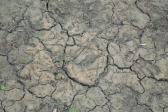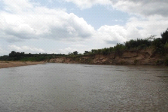4.2.4.4. Awareness and impacts of flood
The awareness to flood hazards may raise the attention of
population on how to manage flood risks. According to the key informants (NGOs
and Public institutions) that were interviewed in the field, the occurrence of
flood in the area does not take the residents by surprise because even though
it is a natural phenomenon, the residents know when the river may overflow and
they received warning on radio and through the sign posts implanted to
indicate the water level. Equally, they are aware of flood-related risks in the
area. The analysis shows that the majority, 94.1% is aware of the flood risks,
while only 4.5% said they are not aware. A majority of the households (84.6%)
said they had warnings about the threat of flood and how to handle its effects,
while 13.6% said they did not have any prior warning about the impending threat
of flood. Looking at the 2010 flood which was exceptional in the area according
to the population, 86.9% were aware of the 2010 flood occurrence while only
9.5% said they were not aware.
Regarding the different ways for passing information on flood
threat, 77.8% of the total respondents said they received information by
radio, while 2.7% and 0.09% said they received warnings about floods by
traditional ways and through volunteers of the Red Cross, respectively.
Furthermore, despite the threats caused by flood in those communities, they
still live in the same area for several reasons. The majority of the
respondents (47.5%) reported they have nowhere to go, 22.2%, 12.7%, and 8.6%
reported respectively that it is hard to find farmland elsewhere, that the
lands are for their ancestors, and the lands of the area are fertile.
In terms of the impact of 2010 flood, 96.4% of the
respondents had been affected in various ways (loss of crops, destruction of
houses, loss of animals, loss of important assets etc.) and 2.7% said they had
not been affected.
4.2.4.5 Environmental
conditions
The extent of environmental degradation has also an important
role to play in exacerbating community vulnerability. The field survey revealed
that the study area is subjected to the fragmentation of the river bank digging
and widening the river channel, the soil degradation "photo 6 and 7" and
removing of vegetation along the river bank which leaves the soil exposed and
increase surface runoff and then flood extent. AGO et al (2005) observed that,
the soil degradation, the deforestation of the floodplain, the increase in the
number of human settlements in the river boundary increases the vulnerability
of population to flood hazard.
 
Photo 5: Dehydrate soil in Batoe village,
Photo 6: Mono River bank fragmentation Photograph taken during field work
in Mawussou village, Photograph taken during field
work
4.2.4.6. Household coping
mechanisms
The occurrence of flood hazard affects people in different ways.
The affected people are forced to employ coping strategies. Various
preparedness and coping mechanism are adopted by the surveyed households.
Advanced preparation, training and planning will facilitate the evacuation
processes (Ekotu, 2012:101). The majority of the respondents of the total
sample (58.4%), reported they employed preparedness measures to reduce flood
impact and (48%) have used reactive measures to cope during. They employed
pro-active measures such as the use of short cycle seeds (6.3%), early harvest
(13.1%), preparation of evacuation place (9%), protection of food supply (5%),
putting of important assets in safe place (12.2%). Respondents reported to
employ reactive measures, such as tire track (1.8%), sandbag track (11.8%),
backfilling with sand (22.6%), backfilling with palm kernel shells (5.9%), and
pumping (0.09%). The use of those pro-active measures as well as the reactive
measures by the population were confirmed by Red cross institution of the Yoto
district that is highly involved in disaster risk reduction in the targeted
areas.
During and after flood disasters, most of households do not have
any assistance from government and there is no policy to help the communities
out. Each household, then, relies on itself and on their families and relatives
in non-flooded area to cope with flood.
Despite the existing anticipatory information in the study
area there is no adequate strategy to increase population's resilience to flood
disaster. This calls to think on alternative solution to increase adaptive
capacities of population. According to the key informant interview, population
in vulnerable areas should firstly change their mentality in order to accept
their relocation in a safe areas, they should build strong houses and adopt an
appropriate agricultural practices adapted to their area and the use of short
cycle seeds to increase their resilience.
| 


